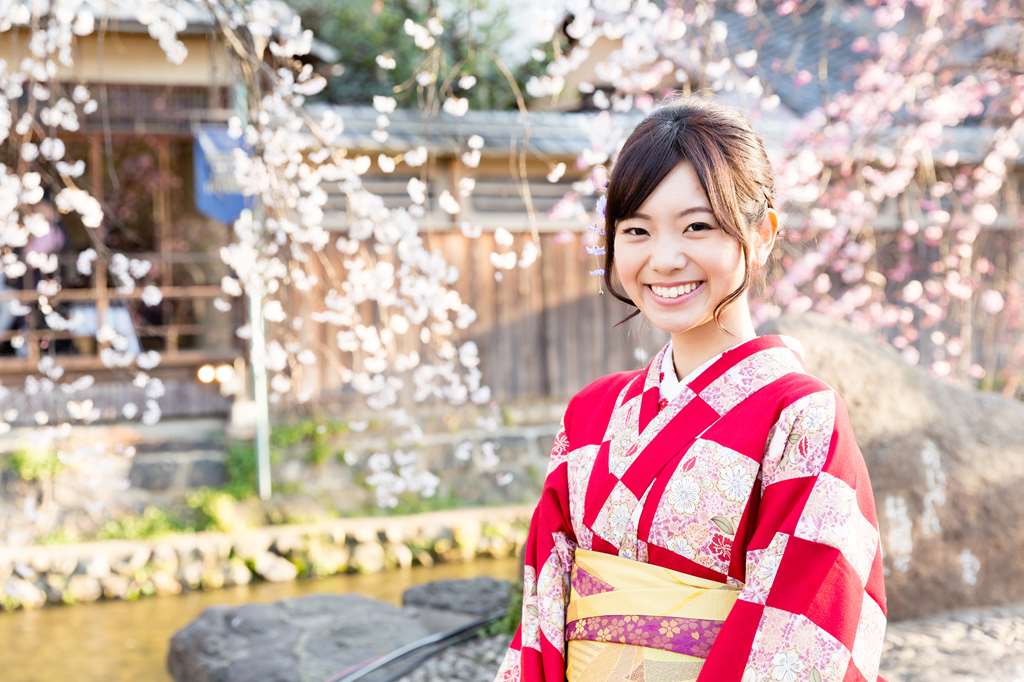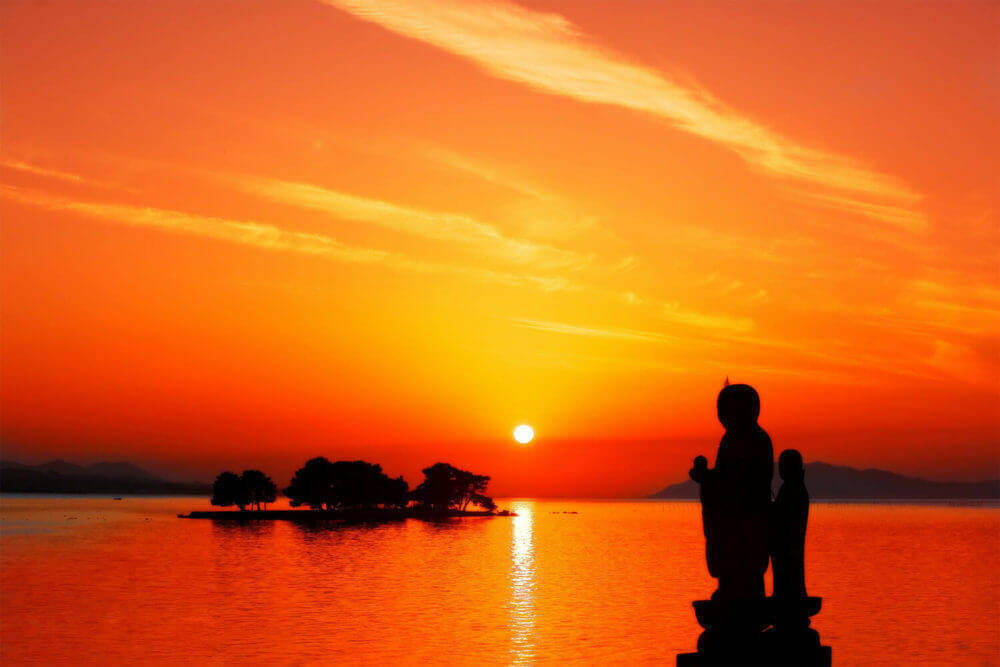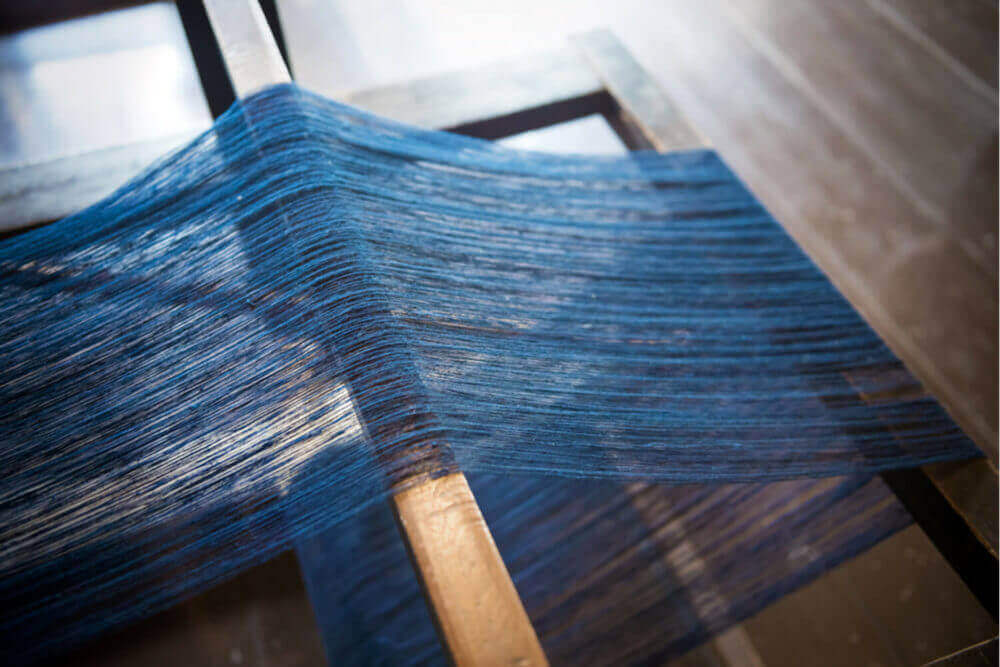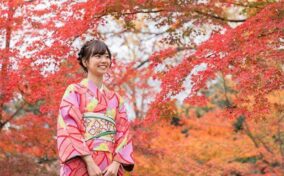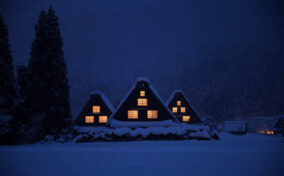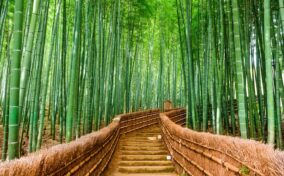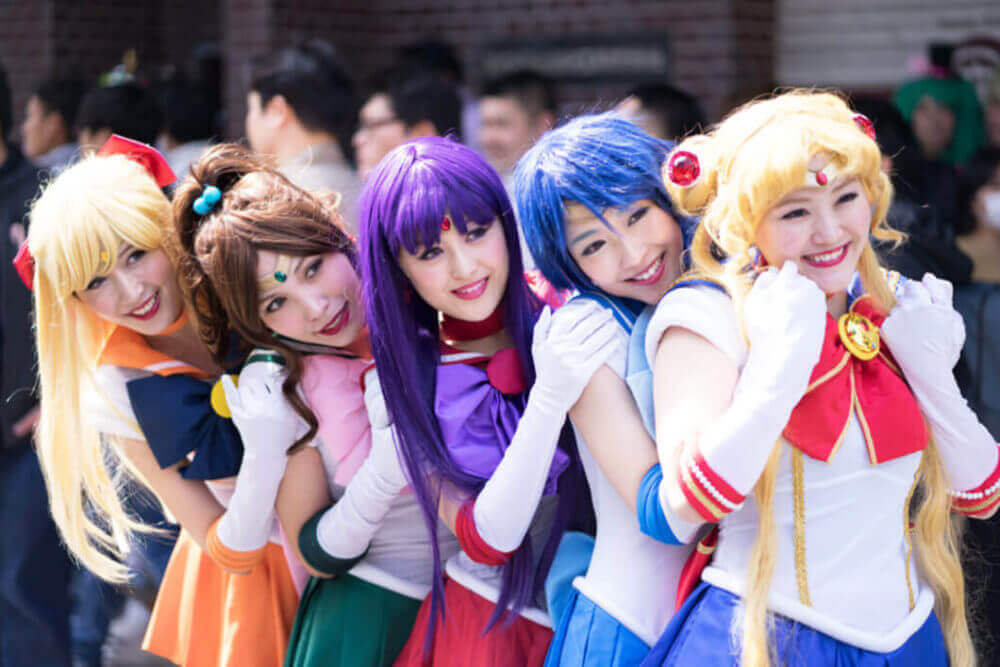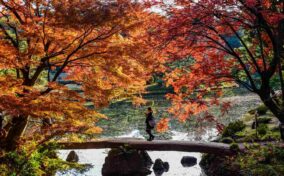In Japan, there are many traditional old things left. For example, temples and shrines. There are also sports such as sumo, kendo, judo, and karate. There are also many unique facilities such as public baths and izakayas in urban areas. And there are various traditional rules in people’s lives even today. Respect for tradition is one of the great characteristics of Japanese people and the truth of Japanese culture. On this page, we will introduce representative examples of traditional Japanese culture that we would like you to know.
Table of Contents
Traditional Japanese culture
Geisha
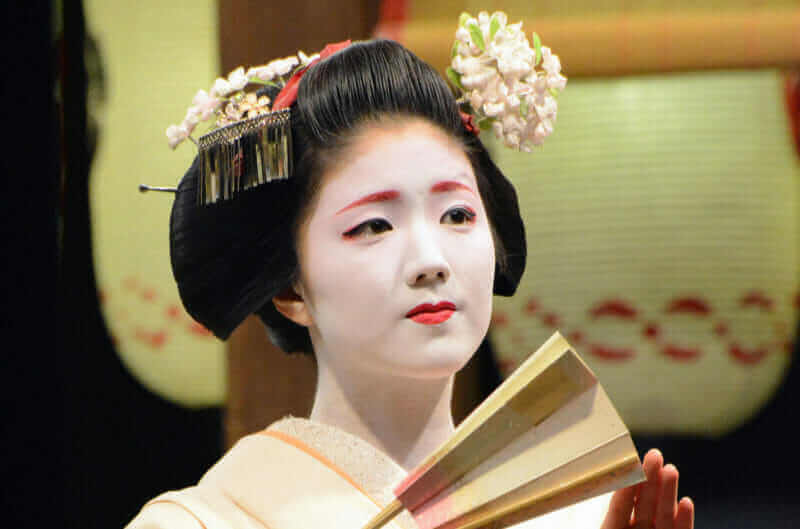
A Japanese geisha performs for a public event at a shrine in Kyoto = shutterstock
Geisha is a woman who hospitals guest at the banquet by Japanese dance and Japanese songs. In modern Japan almost no longer exists, but still in Kyoto.
In Kyoto, Geisha is called “Geiko”.
There are people who misunderstand the geisha as a woman selling herself. Geisha are quite different from women of that type. On the contrary, Geisha has acquired various cultures in addition to Japanese dance. They can entertain the wealthy guests with advanced education.
“Maiko” is a young woman training in Kyoto, aiming at Geiko. They are in Gion. If you walk in the traditional street of Gion, you will be able to see those walking with beautiful kimonos.
When you visit Japan, please enjoy a limited program to experience a Geisha (Maiko or Geiko). You can make a reservation by clicking here. All programs are limited in number.
Kabuki
Kabuki is a classical Japanese dance-drama which continues from the beginning of the 17th century. The person who created Kabuki was a legendary woman named “Okuni”. At the beginning there were female performers as well. Kabuki was a representative pop culture of this era.
However, afterwards, female performers were exiled by government orders who disliked obscene performance. For this reason, since the middle of the 17th century, Kabuki became a dance drama that only men play. Amid such restrictions, the performers devised and created unique beautiful scenes.
Toshiro Kawatake, a famous Kabuki writer, explained in his book “Kabuki: Baroque Fusion of the Arts“, “Noh is classical, like ancient Greek drama, while Kabuki is Baroque, analogous to Shakespeare” .
I have interviewed Mr.Kawatake many times before. Until then I was not good at kabuki. Because I was not sure what the performers are talking about on the stage. However, after receiving advice from Mr.Kawatake, I decided to enjoy the beauty of the whole stage. Then I got to enjoy Kabuki very much.
Why do not you enjoy Japanese baroque dance drama?
If you want to see Kabuki in Japan, we recommend joining this Kabuki guided tour in advance. After that, it will be possible to arrange tickets for performances at the Kabuki Theater in Ginza, Tokyo. Please check this site for details.
Sumo
Sumo is a wrestling competition developed independently in Japan. Big sumo wrestlers collide with each other within the determined circle. Sumo wrestlers get victory either by pushing the opponent out of the circle or rolling him to the ground.
Sumo is often regarded as one of sports competition in modern times. But sumo is actually a traditional event based on Shinto. In the past, sumo was held and dedicated to the gods at the festival of the shrines. If you go to an old shrine in the province you can find places to sumo in the shrine.
Even now, sumo wrestlers perform various rituals based on Shinto. Sumo wrestlers are required not only to be strong, but also to keep good manners.
Check here for Some tour menus to experience sumo in Japan.
Japanese drum
Japanese have used drums for a long time. We have used a lot of drums in shrine rituals and in kabuki and other stages. Japanese drum will echo in your mind and tighten your feelings. I used to play kendo (Japanese fencing) before. Even in Kendo, we did rituals to tap the drums before we started practicing, and when we finished practicing we beat the drum as well.
From the latter half of the 20th century, artist groups who seriously performed these Japanese drum performances appeared and began to hold concerts abroad. If they come to your country, please go and see.
Please check here for the tour menu to experience taiko in Japan.
Traditional Japanese life
From here, I will introduce the traditional things rooted in the lives of the Japanese people. First of all, I will explain what you encounter while walking around the city when you came to Japan.
Traditional things in the cities of Japan
Sento
Sento is a Japanese style public bath. There are hot springs in part, but many of Sento boil hot water. There are many places where a chimney is installed for its exhaust. This chimney is like a symbol of Sento.
In ancient times, it is said that temples and shrines had established public baths for poor people. In the Edo period (17th century – 19th century), it was forbidden to establish a bath in families other than the privileged class in order to prevent a fire in Edo (Tokyo). For this reason many Sento were born.
Bathing was fun for the common people. In some large Sento, Rakugo, a traditional Japanese storyteller, was played. Sento in the Edo era was not divided between men and women, it was common to enter together.
Recently, since most of the households have baths, the number of people using Sento has decreased considerably. However, some Sento still continues to operate. Besides this, large bathing facilities (Super Sento) which users can enjoy various types of baths have appeared and are gaining popularity.
If you are interested, please try to experience a super sento when you visit Tokyo. Click here to check out the popular Super Sento in Tokyo. It is also possible to stay here, so it is recommended as a place to stay.
Izakaya
Izakaya is a Japanese style pub. Various alcoholic beverages are offered at Izakaya, mainly sake, shochu, beer. The menu of foods is diverse.
Izakaya developed during the Edo period (from the 17th century to the 19th century), and since then it was a place where men gathered and drunk. However, in modern times, diverse people, including women, are using it. Alcohol and food of the type popular to women are also prepared.
Many Izakaya are attractive as they are cheaper than restaurants, luxury hotel pubs and the like. The meal is substantial, too.
Recently, tourists from overseas also use Izakaya a lot. It is a popular reason to enjoy the atmosphere of Japanese people.
There are several tour menus to experience Japanese izakaya. Please find your favorite on this site.
Traditional things in the lives of Japanese people
Tatami
Tatami is the flooring material used in Japanese houses. In traditional Japanese houses, many rooms are covered with a number of rectangular tatami mats. On the surface of tatami mats countless numbers of plants called rush (rush) are knitted.
I think that sometimes you are invited to a room with tatami mats when you go to a Japanese house. In such a case, please try to lie down on the tatami mat. Perhaps you feel very comfortable. In humid Japan, tatami mat is very comfortable.
It was not so long ago that tatami mats came to be spread in Japanese houses. Previously, many houses in Japan had wood boards laid. Tatami mat was laid only in the place where the person of the privilege class sits. In the Edo period (from the 17th century until the 19th century), a lot of tatami mats spread, but at the farmers etc, the floor of the earth or tree was conspicuous yet.
Recently, the number of Western-style houses has increased in Japan, and the number of houses that lay tatami mats in the room is getting smaller and smaller. However, in temples and Ryokan (Japanese style hotel), I think that you will see tatami mats again and again. Please try to touch the beautiful tatami mat made by craftsmen.
Fusuma
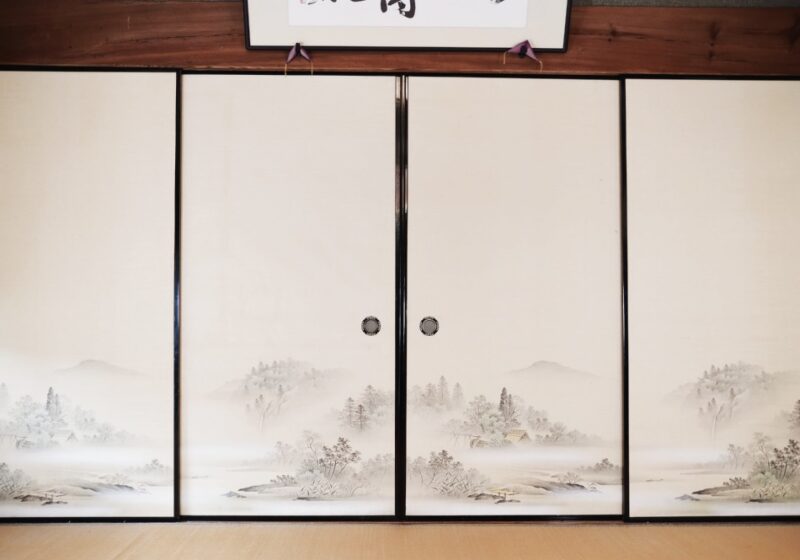
FUSUMA(襖)
In traditional Japanese houses, “Fusuma” was used to separate rooms and rooms. Fusuma is made by pasting paper or cloth on both sides of a wooden frame. When going in and out of the room, we slide Fusuma sideways.
Fusuma is simply pasting paper or cloth, so you can easily break it. When I was a child, I was playing in the room, kicking Fusuma and breaking it, I got scolded by my grandmother. I think that there are many Japanese who have similar memories.
Since Fusuma has little sound insulation, the former Japanese people would have heard easily what the people in the next room are doing. Previously, I stayed alone in a Japanese-style hotel operated from the Edo period (from the 17th century until the 19th century). Even then, I heard almost all the voices of people in the next room. Personally I am not good at this kind of thing.
When you go to a big temple, you can see Fusuma with beautiful pictures on the surface. It seems that old wealthy people enjoyed the paintings of each Fusuma. It probably means that there were no violent children near those Fusuma.
Shoji
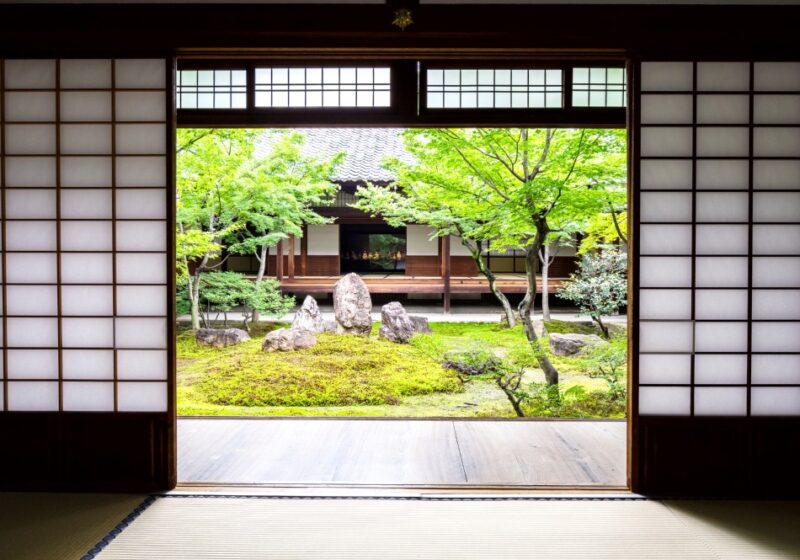
SHOJI(障子)
Shoji is very similar to Fusuma. However, Shoji is often used to partition the room from the corridor into which the external light penetrates. Shoji is made by pasting Japanese paper on a wooden frame. Japanese paper is so thin, outside light goes a little. By using Shoji, the Japanese room was filled with sunlight and became bright. Shoji shields the light a little, so not a strong light in the room, but a gentle light inserted.
I have heard the theory of an American sociologist who says “Shoji’s barrier is blocking Japanese career women.” Regardless of how women are promoted, men are doing business in the back of Shoji. Women are never able to go to the back of Shoji. Women can surely see the shadows of men through shoji, but they can not participate in decision making. I thought it was an interesting theory. Shoji is thin, but its presence is great.
Futon
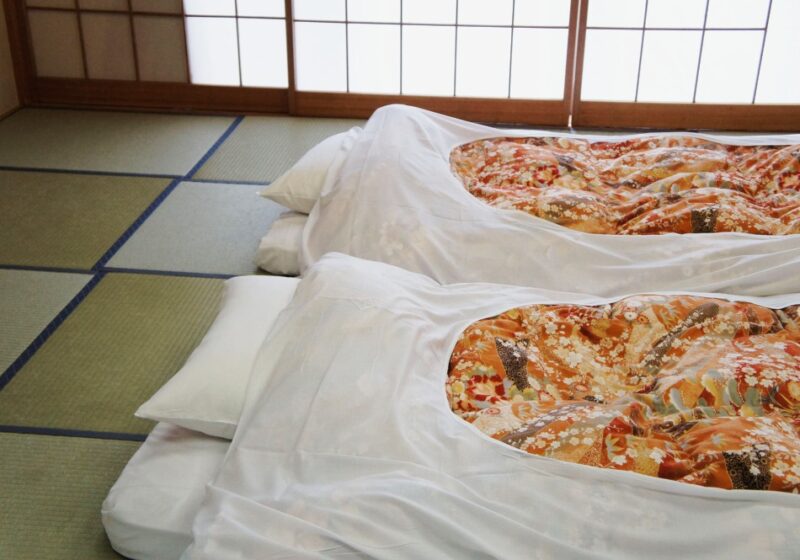
FUTON(布団)
“The Japanese sleep on the floor, not on the bed.” Sometimes I hear such a voice from overseas. This is not a mistake, but it is not accurate. The Japanese lay Futon on the tatami floor. And sleep on that Futon.
Futon has two types. One is Futon spreading on tatami. We will lie on this. The other is Futon over us. This Futon is soft and warm.
If you stay at Ryokan (Japanese style hotel), you can sleep with Futon. Please try it.
In Japanese houses, we do not put the bed and lay Futon only in the evening. In this way, we can use the room extensively for various purposes during the daytime. If we dry Futon in the daytime, we can also prevent humidity. Futon is very useful.
However, in recent years, many Japanese have come to sleep in bed instead of Futon. Because the tatami room is decreasing.
Personally, I like Futon. I still lay Futon in the room of Tatami, sleeping comfortably!
Traditional Japanese technology that are still inherited
Kintsugi Repair
There are various traditional technology in Japan. Among them, the one I specifically want to introduce is the technology called Kintsugi.With Kitsugi’s technology, we can join the fragments and return them to their original shape even if the ceramics break.
This technology has been handed down by skilled craftsmen for a long time. Craftsmen use lacquer to join pieces together. Lacquer is a type of sap and serves as an adhesive. Next, they apply gold powder to the connected part. Please see the above video for details.
Kintsugi is also called kintsunagi. What is behind this technology is the spirit of Japanese tea ceremony. In the tea ceremony, we accept things as they are. If it cracks, we enjoy broken scenery.
Modern people often thrown away immediately if something breaks. In such a modern day, Kintsugi tell us another beautiful way of living.
Unfortunately, you can not easily buy Kintsugi’s products. Kitsugi is a thing you ask a craftworkman to do when your favorite teacup breaks. However, at the first floor of “Hotel Kanra Kyoto” in Kyoto, craftsmen operate “kitsugi studio RIUM”.
Tatara & Japanese swords
Finally, I would like to introduce traditional techniques related to Japanese sword.
All Japanese swords are made of special iron. The iron is produced by the traditional steelmaking method “Tatara” introduced in the above movie.
This steelmaking is done only in Okuzumo located in the mountainous region of western Honshu from January to February every year. It is continued by skilled craftsmen. The craftsmen build a large furnace with viscosity. Put iron sand there and heat it at a relatively low temperature with charcoal. In this way extremely pure iron is produced.
It takes four days and nights once to produce iron. The craftsmen pray to God first, after that, continue to adjust the fire almost without going to bed. They finally break down the furnace and take out the hot iron that flows out.
I have been to the scene once. It was around 5 am in February. It was snowing. Flame in the furnace gave up as if it was a dragon when craftsmen entered the wind. I was getting burned because of the strong heat. Craftsmen fight against flames on the spot for four days. They have terrible mental power and physical strength. When I interviewed them at a later date, their faces were red with burns.
Okuzumo is a beautiful and mysterious mountain village that became the stage of the Japanese myths such as the famous “Yamata no Orochi legend”.
Unfortunately, this steelmaking is not open to the public. Because to produce iron is also a sacred ceremony. However, in Okuzumo there is a special museum “tatara and sword museum” to introduce this steelmaking. In this museum, demonstrations of Japanese swords are also being performed, as introduced in the above movie.
Currently, Japanese swords all use iron produced by “Tatara” of Okuzumo. Because iron produced at a modern factory can not make a sharp and hard sword. This “Tatara” is operated by a public benefit foundation that preserves Japanese sword production technology. This foundation also has a Japanese sword museum in Tokyo. If you really want to see a Japanese sword, I would recommend going to the National Museum in Tokyo or the following museum operated by this Foundation.
>> The official website of the Japanese Sword Museum is here
Thank you for reading to the end.
Now, let’s plan to make your vacation in Japan the best experience ever!

